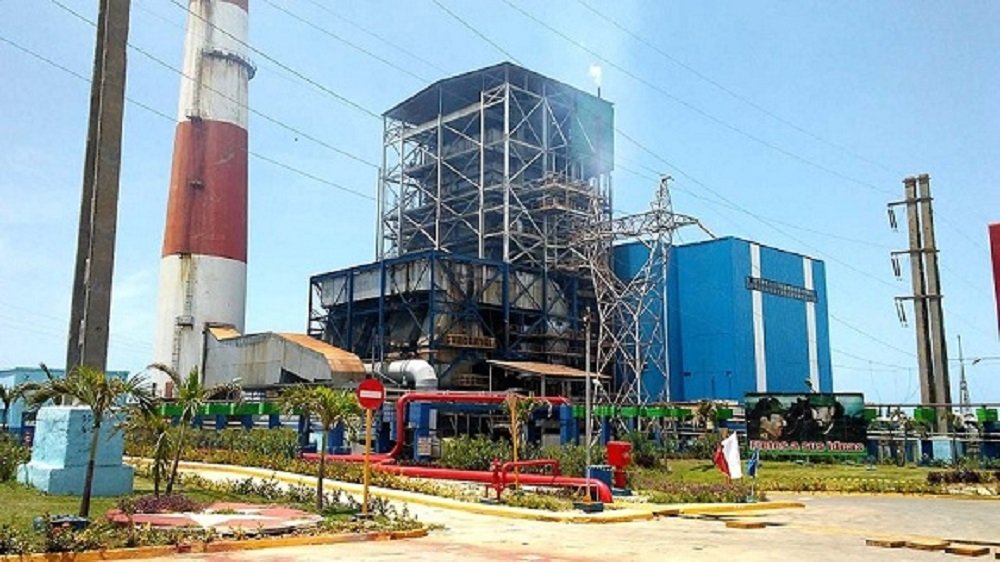The Thermoelectric Power Plant (Cte) Antonio Guiteras, the largest of its kind in the country and located in the province of Matanzas, was disconnected at dawn this Monday from the National Electroenergetic System (SEN) due to maintenance needs, according to official media on the Island.
The scheduled disconnection occurred at 02:23 a.m. It is expected to generate electricity again for its reincorporation into the system next Thursday during peak hours, according to a statement issued by the Electric Union (Une) and reviewed by the official Cubadebate website.
That medium refers that in the same morning the reconditioning work began, in which more than 300 workers from the company in charge of maintaining the country’s power plants are involved.
The work schedule, scheduled to be carried out in 72 hours, includes some 166 tasks, including cleaning of regenerative air heaters, solution of high temperature area in boilers, and some light maintenance, points out a report of the Cuban News Agency (Acn).
Román Pérez Castañeda, main specialist of the imports group at the plant, explained that the shutdown will increase reliability and, at the same time, increase power above 200 megawatts (MW), the publication refers.
There is uncertainty regarding the magnitude of the problems that we could find, which would definitively dictate the depth of the corrective actions and the time of duration, Pérez Castañeda told the Acn.
Misbel Palmero Aguilar, general director of the plant, confirmed to the media that at the time of stopping its operations, the most efficient unitary block in the country generated 170 MW, a figure well below installed and actual capacity.
The agency recalls that the CTE Antonio Guiteras already has three decades of exploitation and stands out among its peers for being in the western part of the Island, where the largest loads are concentrated, and for consuming national crude oil by pipeline, without the need for expenses for transportation concept, among other advantages.
The Cuban SEN has been subjected to great tension during the last month. The fuel deficit, added to the constant stoppages of the thermoelectric plants due to breakdowns and lack of maintenance, has generated annoying blackouts that affect both the state and residential sectors.
Last week the specialists managed to launch Block 1 of the CTE Lidio Ramón Pérez, from Felton, located in the eastern province of Holguín, which was also out of the system for “maintenance that cannot be postponed” due to the dirt accumulated in the boiler, causing significant damage.
Felton Unit #1 maintains its generation stable at 250 megawatts, while electrical workers in #2 continue partial capitalizable maintenance. #CubaForLife #loquenosUNEcompromiso pic.twitter.com/RPOynRnK6G
— Electric Union (@OSDE_UNE) June 27, 2022
This Monday, the Une reported through its Twitter account that said block continued to generate 250 MW in a stable manner, and that block 2 remained under partial capitalizable maintenance.
However, the entity in charge of generating and distributing electricity on the island made it known that during the peak hours of the day there would be an availability of 2,571 MW and a maximum demand of 2,780 MW, for a deficit of 209 MW, so that if the forecast conditions are maintained, an affectation of 280 MW is forecast at the peak.
The electricity generation It has been one of the biggest problems faced by the Cuban government in the midst of the economic crisis, aggravated by the COVID-19 pandemic, the embargo/blockade imposed by the United States, and the limited effect of the measures taken to update the economic model. .
To mitigate the impact of the deficit and the blackouts, one of the triggers of social unrest translated into the protests of last July, the Cuban authorities have implemented, with greater or lesser success, some alternatives, including the incorporation of several floating plants from Turkey to the SEN.















